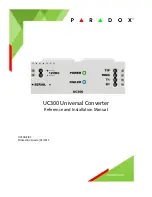
Design Guide & Applications Manual
For VI-200 and VI-J00 Family DC-DC Converters and Configurable Power Supplies
VI-200 and VI-J00 Family Design Guide
Rev 3.4
vicorpower.com
Page 96 of 97
Apps. Eng. 800 927.9474
800 735.6200
Soft Line.
A condition where there is substantial impedance
present in the AC mains feeding input power to a power
supply. The input voltage to the power supply drops
significantly with increasing load.
Split Bobbin Winding.
A transformer winding technique
where the primary and secondary are wound side-by-side
on a bobbin with an insulation barrier between them.
Standby Current.
The input current drawn by a power
supply when shut down by a control input (remote inhibit)
or under no load.
Stiff Line.
A condition where there is no significant
impedance present in the AC mains feeding input power
to a power supply. The input voltage to the power supply
does not change appreciably with load.
Switching Frequency.
The rate at which the DC voltage
is switched on and off in a switching power supply.
T
Temperature Coefficient.
The average output voltage
change expressed as a percent per degree Celsius of
ambient temperature change. This is usually specified for
a predetermined temperature range.
Temperature Derating.
Reducing the output power of a
power supply with increasing temperature to maintain
reliable operation.
Thermal Pad.
A phase change material (ThermMate)
used as a thermal interface between the converter and
a heat sink or chassis.
Thermal Protection.
A power supply protection circuit
that shuts the power supply down in the event of
unacceptably high internal temperatures.
Topology.
The design type of a converter, indicative of
the configuration of switching transistors, utilization of
the transformer, and type of filtering. Examples of
topologies are the Flyback, Forward, Half Bridge, Full
Bridge, Resonant and Zero-Current-Switching.
Tracking.
A characteristic in a multiple output power
supply where any changes in the output voltage of one
output caused by line, load, and / or temperature are
proportional to similar changes in accompanying outputs.
Transient Recovery Time.
The time required for an
output voltage to be within specified accuracy limits after
a step change in line or load conditions.
True Power.
In an AC circuit, true power is the actual
power consumed. It is distinguished from apparent power
by eliminating the reactive power component that may
be present.
U
Undershoot.
A transient output voltage change which
does not meet the low limit of the voltage accuracy
specification and is caused by turning the power supply
on or off, or abruptly changing line or load conditions.
Universal Input.
An AC input capable of operating from
major AC lines worldwide, without straps or switches.
V
VI Chip
®
(VIC).
VI Chips are the smallest power
components available today — about the size of a 1/16
brick and very power dense. They can be used as building
blocks to replace existing circuits (quarter bricks and silver
box power supplies). VI Chips offer flexible thermal
management: a low thermal impedance package and the
design of the package simplifies heat sink design.
Voltage Balance.
The difference in magnitudes, in
percent, of two output voltages that have equal
nominal voltage magnitudes but opposite polarities.
Voltage Mode.
A method of closed loop control of a
switching converter to correct for changes in the output
voltage.
W
Warm-Up Drift.
The initial change in the output voltage
of a power supply in the time period between turn-on
and when the power supply reaches thermal equilibrium
at 25°C, full load and nominal line.
Warm-Up Time.
The time required after initial turn-on for
a power supply to achieve compliance to its performance
specifications.
X
X-Capacitor.
A capacitor connected across the supply
lines to suppress normal mode interference.
26. Glossary of Technical Terms
Summary of Contents for VI-200 Series
Page 100: ......




































